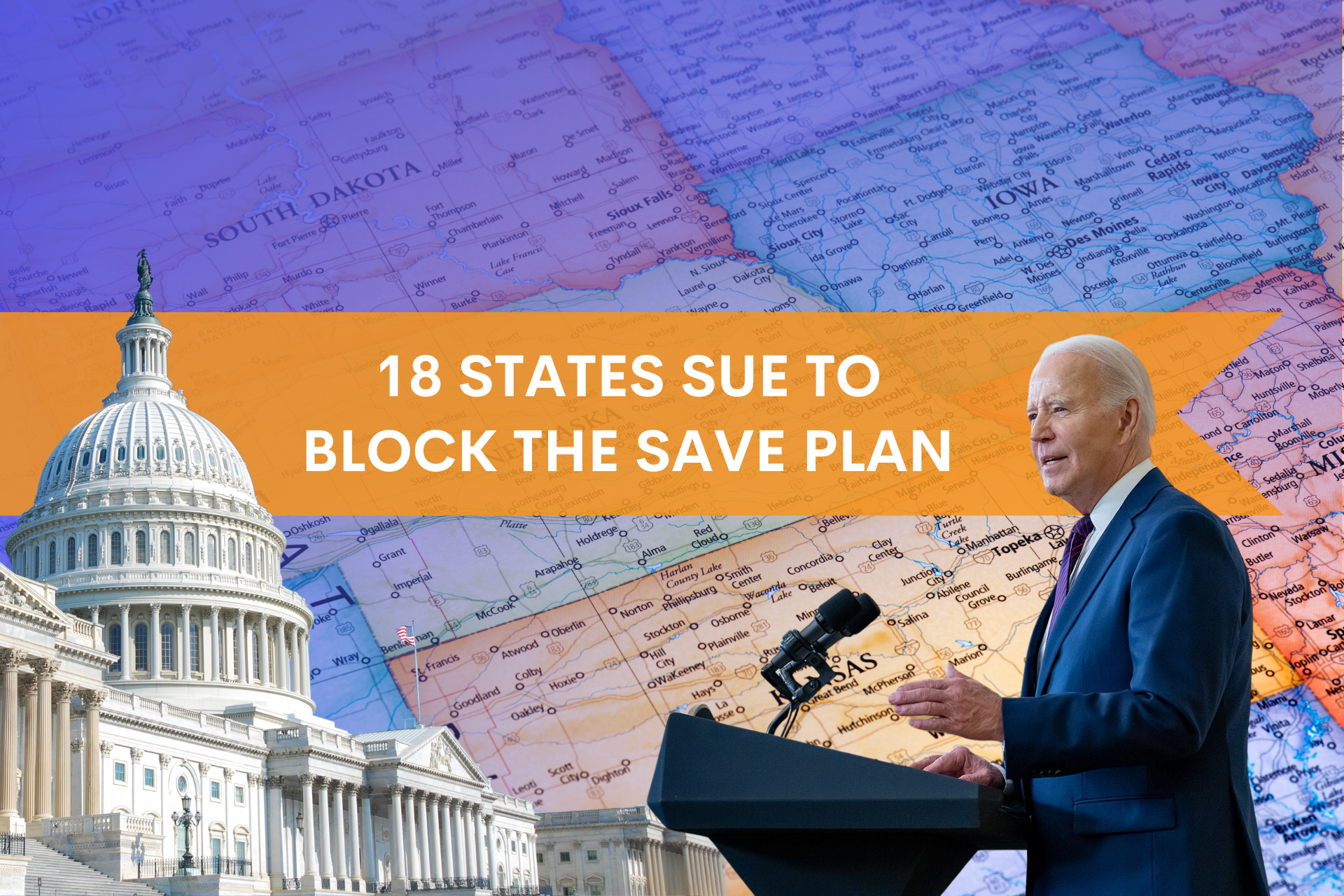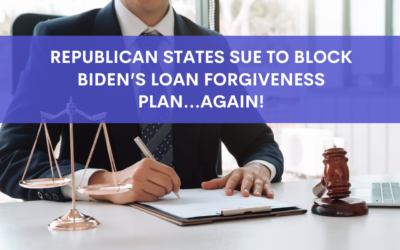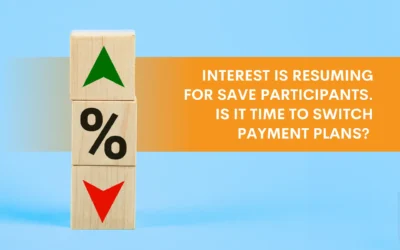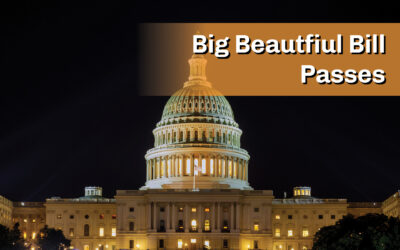Scroll to bottom for the latest updates!
In March 2024, the State of Kansas filed a lawsuit in Federal court to block President Biden’s Saving on a Valuable Education (SAVE) plan. Shortly thereafter, the state of Missouri filed a similar lawsuit (on behalf of Mohela) and within two weeks, a total of 18 states became involved in one of these two lawsuits. Below is a summary of the direct allegations in the Kansas lawsuit. While we’ve combined and simplified many of the accusations to make them shorter and easier to digest, we want to emphasize all of the allegations below (quoted or not) are from the lawsuit and not our own. We are not forming any opinions on this matter. Our aim is to keep you objectively informed as we’ve done with other lawsuits related to student loans. As this case progresses through the courts, we’ll continue to update this article.
Overview
This suit is directly aimed at President Biden, the Department of Education (DOE) and the Secretary of Education, Miguel Cardona. The suit alleges the administration overreached and bypassed Congress with the SAVE plan (referred to as the “Final Rule” below) by allowing borrowers to avoid paying back much of their debt via ultra-low payments and new forgiveness provisions. Plaintiffs are calling the SAVE plan a partial grant instead of a loan repayment plan, therefore breaking all sorts of mandates under the Higher Education Act (HEA). SAVE gives the Secretary a huge amount of discretion to write and change both IDR program rules and “waiver” (forgiveness) provisions, which the Plaintiffs have major concerns about. They also claim the DOE broke some procedural rules in the process. Taken together, all of this allegedly defies the Supreme Court decision in Nebraska vs. Biden less than a year ago, likely setting the stage for another SCOTUS decision.
Allegations
- Back in 1993, the premise of direct government lending was there would be no ultimate cost to the government because the loans would accrue interest and eventually get paid back. The cancelation of the remaining balance (if any) at the end of the 25-year period (under ICR) was designed to be a narrow and rare exception rather than the rule.
- Congress has set very specific limits on loan forgiveness. Nevertheless, the DOE has tried to give itself the power to set its own lower thresholds. The Department has attempted to unilaterally override some of these statutory provisions through the rulemaking process to make them more generous. Circumventing congress, both PAYE and REPAYE were issued via executive order, and allowed borrowers to pay back less money, but still more than they originally borrowed. “However, the data within the Final Rule demonstrates that the average undergraduate borrower under the new SAVE Plan would pay only about $6,121 for every $10,000 borrowed.”
- The Congressional Budget Office initially estimated the SAVE plan would cost $156B. However, it was written before SCOTUS struck down Biden’s first attempt at forgiveness which would have already cancelled $430B before SAVE went into effect. This estimate still has not been updated as of April 2024, and ultimately should include much of the unforgiven debt still out there. The suit alleges the true cost of SAVE is basically unknown, but likely closer to $430B than $156B.
- “The Congressional Budget Office also noted that Defendants’ estimate assumed that there would be no increase in enrollment in the proposed IDR plan among current or future borrowers and no increase in borrowing among eligible students in the future.”
- During the comment period of negotiated rulemaking multiple commenters challenged the legal authority of Defendants to implement these regulations, including: (1) acting in excess of statutory authority, (2) implicating the major questions doctrine, and (3) promulgating a rule that is arbitrary and capricious. DOE seemingly ignored these comments and pressed forward with the plan.
- “” In effect, the Rule transforms the REPAYE Plan into a system of massive federal grants whereby borrowers pay only a fraction of the amount borrowed from the government. The remainder of the loan is forgiven. Thus, while styled as “loans,” the Final Rule partially transforms many or most loans into outright grants from the federal government—without any appropriation from Congress for the resulting tens or hundreds of billions of dollars in additional federal spending.”” The HEA does not authorize the secretary to provide grants.
- “” The Final Rule asserts the Secretary has the “authority to make the changes in this rule related to the amount of income protected from payments, the amount of income above the income protection threshold that goes toward loan payments, and the amount of time borrowers must pay before repayment ends.” Aside from the APA’s procedural requirement of providing a rationale, the Final Rule does not acknowledge any limiting principle on the Secretary’s authority to abolish debts. It recognizes no substantive limit in the assigned statutory authority under the HEA whatsoever. To put this in perspective, there is nothing in the Secretary’s interpretation of the HEA that would prevent him from limiting debt repayment on income-driven repayment plans to 1% of income over $1,000,000 for 1 year only, with all remaining debt—typically 100%— cancelled by the federal government.””
Standing, Harm, and Claims for Relief
You may recall from the previous Biden lawsuit that standing was a big issue. Generally, plaintiffs must show harm in order to bring a lawsuit. Three examples of harm are cited in the Kansas case:
- Forgiveness under IDR plans (not PSLF) is taxable at the Federal and state level. But under the American Rescue Plan, no loan forgiveness will be taxed through 2025. With Biden fast-forwarding the 10-year forgiveness provisions of SAVE before the program even goes into effect (7/1/2024), states lose the tax revenue they would have typically collected under IDR forgiveness.
- States benefit greatly by using PLSF as a recruitment and retention tool. Large amounts of debt forgiven through the SAVE plan water down the impact and appeal of PSLF. Allegedly, this makes it more difficult for states to recruit and retain teachers and other government employees.
- In Biden’s first attempt at forgiveness the DOE acknowledged there would be an increase in fraud with companies trying to take advantage of borrowers. Plaintiffs assume that will be the case with the SAVE plan as well, alleging there will be increased costs to the states by their law enforcement agencies having to pursue the fraud.
- Of course, we already know the standing in the Missouri/Mohela lawsuit: Mohela loses loans to service, which decreases their revenue, thereby decreasing state revenue.
Ultimately, the plaintiffs claim harm to their states, violations of the Separation of Powers between the Executive and Legislative Branches, and create issues with the Major Questions Doctrine which the court needs to consider. The plaintiffs specifically request, “a declaratory judgment holding the Final Rule unlawful” and, “a judgment vacating and setting aside the Final Rule”. It is unclear at this time how a judgement, as requested, would impact current SAVE participants when it comes to questions of grandfathering. If forced out of the plan, it would have a significant impact on millions of borrowers, especially with the PAYE plan being phased out this summer.
June 7th, 2024 Update:
In the case brought by Kansas, Judge Daniel Crabtree issued a Memorandum and Order. He concluded that 8 of the 11 states listed in the lawsuit (including Kansas) had no standing to sue and dismissed them from the case. Of the three states which did have standing, he said it was “just barely”. He also said the case was generally weak and went on to pick apart the various complaints. The case moves forward with three state sponsors.
June 25th,2024 Update:
We’ve got major updates on the two lawsuits trying to block the SAVE plan.
First, in the Kansas case, judge Daniel Crabtree has made a major U-turn on the over-all merits of the case. In early June he said the case was generally weak. But in his preliminary decision, just two weeks later, he now says “the plaintiffs are likely to prevail on the first of their statutory claims, i.e., that the SAVE plan exceeds the Secretary’s authority under the HEA.” This is the first time the Secretary has gone beyond the prior “Congressionally-blessed numbers” for IDR plans in terms of poverty level deduction, payment calculation, and length of term until forgiveness. Due to that and the huge price tag, he decided the SAVE plan represents a “transformative expansion”. That is a key term by which only Congress can approve.
Judge Crabtree has granted a nationwide injunction which will prevent the final provisions of the SAVE plan from being implemented on July 1st. This has two major implications. First, the new 5% payment calculation for undergraduate borrowers (and 5-10% for those who have both undergrad and graduate debt) will not happen. Second, 10 to 20 year forgiveness for borrowers owing $12k to $22k will not happen. Luckily, Judge Crabtree was very aware of the public harm and chaos that could have resulted from completely undoing the SAVE plan. He denied the plaintiffs’ request to enjoin the entire SAVE plan.
Judge Crabtree knows that the Biden admin will appeal this decision. So, he issued the injunction as preliminary, gave the defendants 14 days to appeal, and postponed the effective date to June 30th. It is also worth noting that Crabtree dismissed Biden from the lawsuit for lack of jurisdiction, basically implying that a Federal district court cannot preside over a sitting president.
There was also a preliminary decision in the Missouri case. Much of the logic applied by the judge in this case was quite different. Judge John Ross determined that the HEA gives the Secretary very clear authority to change the payment, interest and subsidy provisions of IDR plans as they see fit. “The Court finds that Plaintiffs’ arguments regarding the Secretary’s authority to set payment schedules and interest accrual limitations are unlikely to succeed on the merits.” “Congress does not appear to have either explicitly or implicitly limited the Secretary’s ability to create such a comparatively generous plan.” So that’s an initial win for borrowers and the Biden administration.
Judge Ross took a different tone, however, when it came to the SAVE forgiveness provisions. “The Court also finds that Plaintiffs are likely to succeed on the merits of their argument that the early loan forgiveness provisions of the Final Rule were promulgated in a manner exceeding the Secretary’s statutory authority.” “Congress has made it clear under what circumstances loan forgiveness is permitted, and the ICR plan is not one of those circumstances.” (I think he meant “IDR”, but we get the point.) “Defendants are preliminarily enjoined from any further loan forgiveness for borrowers under the Final Rule’s SAVE plan until such time as this Court can decide the case on the merits.”
In summary,
- SAVE forgiveness in 10 to 20 years is blocked
- The 5% payment is blocked
- Loans that have been forgiven are not being reconstituted
- The SAVE plan as it looks today is not being taken away.
The Biden administration will obviously appeal these injunctions very quickly. It will be interesting to see whether the GOP states appeal their partial dismissals in an effort to block the SAVE plan entirely. Either way, there is much more to come.
July 1st, 2024 Update:
The 10th Circuit Court of Appeals granted the Biden administration’s emergency request to stay (temporarily block) the injunction which would have prevented the new 5% payment calculation from taking effect. With this ruling, that new calculation will proceed as planned. It is unclear exactly when these new payment calculations will show on borrowers’ monthly statements. The administration had stated that it would put nearly half of SAVE participants into an administrative forbearance if the new payment were to remain blocked. Some outlets reported that decision had already been made. We assume this forbearance will not be happening at this time.
thJuly 8th, 2024 Update:
The three remaining states in the “Kansas” lawsuit have filed an emergency appeal with the Supreme Court asking it to stop the SAVE plan. We are waiting to see if the court will grant any sort temporary injunction.
July 22nd, 2024 Update:
On July 18th the 8th Circuit of the US Court of Appeals issued a stay completely blocking the Dept of ED from operating the SAVE plan…for now. On July 19th DOE announced they would put all SAVE plan participants into an administrative forbearance for an unspecified amount of time. No interest will accrue during this forbearance. Unfortunately, this forbearance will NOT count towards PSLF. This is part of the Missouri case. We are still waiting for an initial response from SCOTUS with regards to the request made in the Kansas case for them to step in.
August 9th, 2024 Update:
The 8th Circuit Court of Appeals issued another blow to the SAVE plan today, changing its temporary stay on the program to a preliminary injunction. While not a final ruling, this injunction implies that the court sees some strong merits in the case which could ultimately see SAVE shut down for good. So, they want the plan to remain blocked while the case continues to be litigated. There was one positive development for borrowers, however. The court specifically stated that any actions would not be taken retroactively, and loan forgiveness which has already been granted under the SAVE plan would not be reversed.
Meanwhile, we still await some sort of action or comments from SCOTUS as to whether they will take on the case. We’re a bit shocked that hasn’t happened yet. Until it does, no one (borrowers, DOE, or servicers) really know what the best course of action is. So, we wait…
August 10th, 2024 Update:
Texas Attorney General Ken Paxton sent a letter to the Supreme Court asking them to “grant certiorari before judgment and summarily order the district court to vacate the SAVE Plan, or at least set this case for argument.” In plain English…cancel the SAVE plan once and for all, or put it on the docket so the two sides can battle it out. Either way, this is a second request from Republicans for SCOTUS to step in. We also expect the Biden admin to formally request the high court’s involvement this week. The pressure is definitely mounting for SCOTUS to step in one way or another.
Meanwhile, the 10th Circuit Appeals Court has agreed to expedited oral arguments on August 21st.
August 15th, 2024 Update:
The Department of Education filed an emergency declaration with the Supreme Court requesting that they vacate the injunction against the SAVE plan and allow it to be active while these lawsuits work their way through litigation.
August 28th, 2024 Update:
We finally have our long-awaited answer from the Supreme Court on whether they will temporarily reinstate the SAVE plan while litigation continues. NO! The SAVE plan will remain blocked until the 8th Circuit Court of Appeals makes a final decision. We suspect the 8th Circuit will permanently block the plan. From there, the Biden admin will appeal back to SCOTUS for an actual hearing. Today’s decision is an indicator on how the high court may rule in the long-run… if they take up the case at all. Now the ball is back in DOE’s court to see if they will issue some alternative options for borrowers.
February 28th, 2025 Update:,
After sitting on the case since October, the 8th Circuit finally made a ruling on SAVE. In short, they agreed with the lower court’s decision and broadened the decision to impact ICR and PAYE plans. In-short, The court deems 20- and 25-year forgiveness under ICR, PAYE, REPAYE, and SAVE to be unlawful because Congress did not expressly state that ICR (and the plans that come out of it) should result in guaranteed forgiveness. With IBR, on the other hand, Congress plainly stated that remaining balances would be forgiven after 25 years (and 20 years with their 2012 updates).
The lawsuit is now sent back to the lower courts to adjust their ruling and issue guidance. We’ll see how that goes!
Brandon Barfield is the President and Co-Founder of Student Loan Professor, and is nationally known as student loan expert for graduate health professions. Since 2011, Brandon has given hundreds of loan repayment presentations for schools, hospitals, and medical conferences across the country. With his diverse background in financial aid, financial planning and student loan advisory, Brandon has a broad understanding of the intricacies surrounding student loans, loan repayment strategies, and how they should be considered when graduates make other financial decisions.





